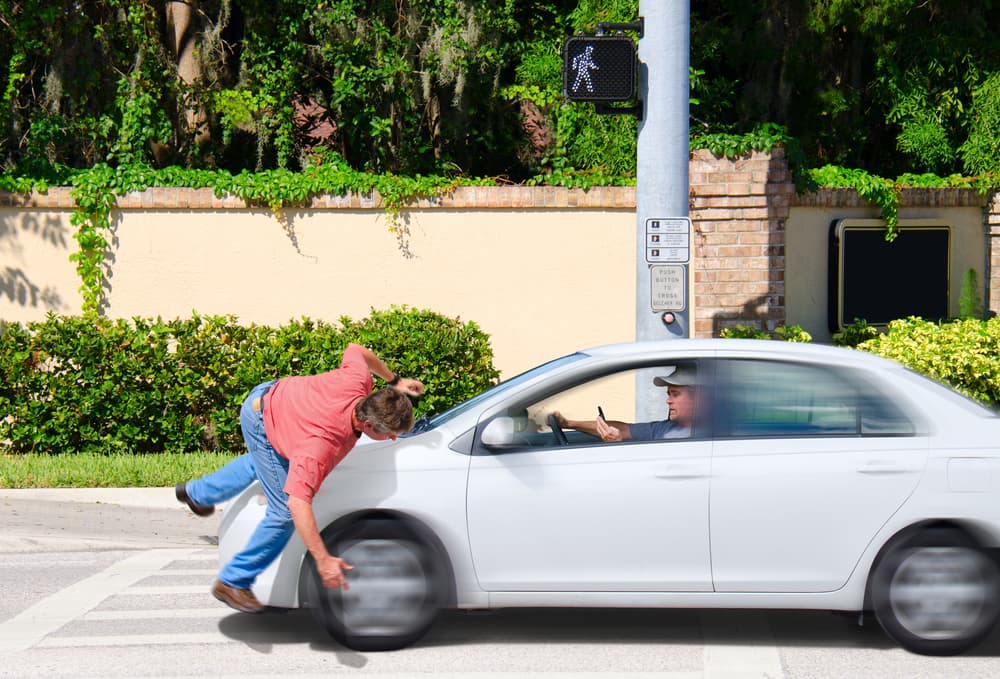Car crashes frequently result from negligent driving maneuvers by others. In a forceful car accident scenario, such as a rear-end collision, victims may suffer severe neck and back injuries, such as soft tissue sprains or broken bones.
If you suffered one of these injuries in a recent car crash, you may be eligible to file a third-party claim seeking compensation for your losses. Since every car accident case is different – and some neck and back injuries are more severe than others – there is no such thing as an “average settlement” in one of these cases. The amount of compensation you recover will likely depend on the severity of your injuries, the extent of your medical treatment, and the circumstances surrounding your collision.
A knowledgeable car accident attorney can evaluate your case, determine your legal options, and pursue the maximum compensation available to you for your injuries.
What Types of Neck and Back Injuries are Most Common in Car Crashes?
 Car collisions can lead to a range of serious neck and back injuries, often due to the sudden impact and jarring motion experienced during a collision.
Car collisions can lead to a range of serious neck and back injuries, often due to the sudden impact and jarring motion experienced during a collision.
- One of the most common neck injuries resulting from car crashes is whiplash. Whiplash occurs when the head suddenly jerks forward and then backward, straining the neck muscles and ligaments. Symptoms of whiplash can include neck pain, stiffness, headaches, and dizziness. In severe cases, victims may also experience difficulty with concentration and memory.
- Another common neck injury is a cervical spine injury, which affects the vertebrae in the neck. A cervical spine injury can range from strains to more severe conditions, such as herniated discs. A herniated disc occurs when the cushioning between the vertebrae slips out of place, potentially compressing nearby nerves and leading to pain that may radiate down the arms.
- Back injuries are also frequent in car accidents. One common type is a lumbar sprain, which involves the stretching or tearing of ligaments in the lower back, which can result in significant pain and limited mobility. Symptoms may include lower back pain, swelling, and difficulty standing or walking.
- Another serious back injury is a herniated disc in the lumbar region. Similar to cervical herniation, this condition can cause intense pain, numbness, or weakness in the legs, as the damaged disc can compress spinal nerves. Treatment often involves physical therapy, medication, or, in some cases, surgery.
- Spinal cord injuries are among the most severe consequences of car accidents. These injuries can lead to partial or complete paralysis, depending on the injury’s location and severity. Victims may experience a loss of sensation and motor function below the injury site, significantly affecting their quality of life.
In addition to physical neck and back injuries, many victims experience emotional distress – including anxiety and depression – due to the trauma of the car accident and its aftermath.
How Do Negligent Drivers Frequently Cause Car Accidents?
Negligent driving is a leading cause of car accidents, and it can take many forms.
- One of the most common types of negligent driving is distracted driving. Distracted driving occurs when drivers divert their attention from the road, often due to texting, talking on the phone, or adjusting the radio. Distractions can lead to serious accidents, such as rear-end collisions, where one vehicle crashes into another because the driver did not notice the car ahead had stopped.
- Driving under the influence of drugs or alcohol is another critical issue. Impaired drivers may struggle with coordination and judgment, increasing the likelihood of accidents. These crashes often involve head-on collisions or rollovers, which can be particularly devastating due to the force involved.
- Another major factor is speeding. Many drivers exceed the speed limit or drive too fast for road conditions. Speeding reduces a driver’s reaction time, making it difficult to stop in time to avoid a crash. Reduced reaction time can result in high-impact collisions, which often lead to severe injuries.
- Reckless driving, which includes aggressive maneuvers such as tailgating, weaving between lanes, and making sudden lane changes, also poses significant risks. These behaviors can cause side-impact crashes, especially at intersections, where one vehicle may collide with another that has the right-of-way.
- Negligent drivers can also fail to obey traffic signals and signs. Running a red light or ignoring stop signs can lead to T-bone accidents, where one vehicle strikes another at a perpendicular angle. These crashes often result in serious injuries due to the nature of the collision.
- Weather conditions can also play a role in negligent driving. Drivers who do not adjust their speed or behavior during rain, snow, or fog increase the risk of crashes, leading to skidding or loss of control and causing multiple-vehicle pile-ups.
- Finally, failing to maintain a vehicle can contribute to accidents. Neglecting issues such as worn brakes or faulty lights can lead to crashes that may have been preventable. Regular maintenance is crucial for ensuring that a vehicle operates safely.
How To Prove Neck and Back Injuries in a Car Accident Case Successfully
Proving neck and back injuries from a car accident can be crucial to securing compensation for medical bills and other damages. To build a strong case, gathering specific types of evidence is essential.
- First, obtaining medical records is vital. Following the accident, visiting a healthcare provider for evaluation is crucial. Medical professionals can document your injuries through exams, imaging tests like X-rays or MRIs, and treatment plans. These records serve as concrete evidence of the injuries sustained and can establish a direct link to the collision.
- Second, keeping detailed records of all medical treatments and expenses is important, including bills for doctor visits, physical therapy sessions, medications, and any necessary equipment like braces or crutches. Documenting these costs can help demonstrate the financial repercussions of your injuries.
- Third, witness statements can be invaluable. If there were people present during the accident who saw what happened, their accounts can support your version of events. Witnesses can testify to the conditions leading up to the crash and how it affected you, providing context for your injuries.
- Fourth, photographs from the accident scene can be beneficial. These images can capture the positioning of the vehicles, road conditions, and any visible injuries. They help illustrate the severity of the accident and may provide insight into how the injuries occurred.
- Fifth, a detailed accident report from law enforcement can also be useful. This report usually includes information about the accident, the parties involved, and any citations issued. It serves as an official record that can corroborate your claims of negligence.
- In addition, keeping a personal journal can be helpful. Documenting your daily experiences, pain levels, and how the injuries affect your life can provide a personal narrative that supports your case. This record can illustrate the effect of your injuries on your daily activities and overall well-being.
- Finally, expert testimony may strengthen your case. Medical professionals can explain the nature of your injuries, the expected recovery time, and the long-term effects. An accident reconstruction expert may also help clarify how the crash caused your injuries.
Collecting this evidence can significantly enhance your chances of receiving fair compensation for your injuries.
Settling or Litigating a Car Accident Neck and Back Injury Case
Settling or litigating a third-party car accident case involving neck and back injuries can be a complex process. Understanding the steps involved and the role of a skilled car accident attorney is crucial for achieving a favorable outcome.
- The first step in the process is to gather all relevant evidence. This evidence includes medical records, accident reports, witness statements, and any documentation of damages incurred, such as medical bills and lost income. An experienced lawyer knows what evidence is necessary to support your case and can compile it effectively.
- Once the evidence is collected, your attorney will typically initiate a demand for compensation from the at-fault party’s insurance company. This demand outlines the details of the crash, your injuries, and the financial losses you have suffered. The insurance company will review the demand and may respond with a settlement offer. Initial offers are often low and may not fully cover your damages. An experienced lawyer will evaluate this offer and negotiate on your behalf, striving to reach a fair settlement.
- If negotiations with the insurance company fail to produce a satisfactory result, your attorney may recommend pursuing litigation, which involves filing a lawsuit in the appropriate court. Your lawyer will prepare the necessary legal documents and ensure they are filed within the statute of limitations, which varies by state.
- During the litigation process, both parties engage in discovery, where they exchange information relevant to the case. This information may involve depositions, interrogatories, and requests for documents. A knowledgeable lawyer will guide you through this process, ensuring that you understand your rights and responsibilities while protecting your interests.
- Following discovery, the case may proceed to trial if the parties have not reached a settlement. Your attorney will present evidence, call witnesses, and make legal arguments to support your claim. A skilled attorney knows how to effectively communicate the consequences of your injuries on your life, helping the jury understand the full extent of your suffering.
- Alternatively, many cases are resolved through a settlement just before or during the trial. Your lawyer will continue to negotiate, leveraging the evidence gathered to push for a better offer.
An experienced car accident attorney can provide invaluable support throughout the process, ensuring that your rights are protected and that you receive the compensation you deserve for your injuries.
Factors That Determine Compensation Amounts in Third-party Car Accident Neck and Back Injury Cases
 Determining compensation amounts in car accident cases involving neck and back injuries involves several factors. Understanding these elements is crucial for victims seeking fair recovery for their damages:
Determining compensation amounts in car accident cases involving neck and back injuries involves several factors. Understanding these elements is crucial for victims seeking fair recovery for their damages:
- Severity of Injuries – The extent of the injuries significantly influences compensation. More severe injuries, such as herniated discs or spinal cord injuries, typically lead to higher compensation amounts due to the increased medical expenses and long-term repercussions on quality of life. Medical documentation detailing the injuries and their effects is essential for establishing this severity.
- Medical Expenses – Compensation for medical expenses includes both immediate and long-term costs. This compensation covers emergency room visits, surgeries, physical therapy, and rehabilitation. Victims can also claim future medical costs if ongoing treatment is necessary. Collecting all medical bills and records is vital in proving these expenses.
- Lost income – If the injuries result in missed work, victims can recover lost income. The amount will depend on the duration of time off work and the victim’s salary. Furthermore, if the injuries affect the victim’s ability to earn in the future, compensation may be adjusted to reflect potential lost earning capacity.
- Pain and Suffering – Compensation for pain and suffering is subjective and can vary widely. This category considers both physical pain and emotional distress the injuries caused. Factors influencing this amount include the duration of pain, the emotional effect of the injuries, and how they affect daily life. Skilled attorneys often use formulas or multipliers to estimate this compensation based on medical bills.
- Insurance Policy Limits – The insurance policy limits of the at-fault driver can cap the amount recoverable. Even if the damages exceed the policy limits, the victim can collect only up to that limit from the insurance company.
- Evidence and Documentation – The strength of the evidence presented also plays a crucial role in determining compensation. Comprehensive documentation, including medical records, accident reports, witness statements, and personal journals detailing the effects of injuries, can significantly influence the amount that an accident victim receives via settlement or litigation.
Contact an Experienced Car Accident Lawyer in Your Area About Your Legal Options Right Away
If you recently suffered neck and back injuries in a car crash that resulted from negligent driving, you are not alone. A skilled personal injury attorney in your jurisdiction can aggressively advocate for you during every stage of the claims-filing and litigation processes and will do everything possible to secure the maximum compensation amount you deserve for your losses.



